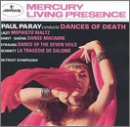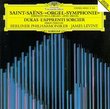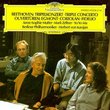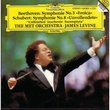| All Artists: Franz Liszt, Carl Maria von Weber, Camille Saint-Saens, Richard [1] Strauss, Florent Schmitt, Paul Paray, Harold Lawrence, Detroit Symphony Orchestra Title: Paul Paray Conducts Dances of Death Members Wishing: 0 Total Copies: 0 Label: Philips Release Date: 6/14/1994 Genre: Classical Styles: Opera & Classical Vocal, Ballets & Dances, Ballets, Forms & Genres, Symphonies, Theatrical, Incidental & Program Music, Historical Periods, Modern, 20th, & 21st Century Number of Discs: 1 SwapaCD Credits: 1 UPC: 028943433624 |
Search - Franz Liszt, Carl Maria von Weber, Camille Saint-Saens :: Paul Paray Conducts Dances of Death
 | Franz Liszt, Carl Maria von Weber, Camille Saint-Saens Paul Paray Conducts Dances of Death Genre: Classical
|
Larger Image |
CD DetailsSimilarly Requested CDs |
CD ReviewsA Rarity, and Vintage Paray, Superbly Played Eugene G. Barnes | Dunn Loring, VA USA | 02/11/2001 (5 out of 5 stars) "A strange hodgepodge of music, but the program works. The major piece here is Florent Schmitt's "La Tragedie de Salome," recorded here the year of Schmitt's death (1958), undoubtedly by a man who knew the composer personally (Paray was the composer's junior by 16 years, and both men had a relationship with the Concerts Colonne). The recording was the only one with which Paray and the Detroit Symphony would win the Grand Prix du Disque. The music is a cross between Debussy and Roussel, with a decided tilt toward the former. The poem (by Robert d'Humieres) on which this suite is based is much more "of the open air" than the claustrophobic Salome of Wilde/Strauss, and while the characters are the same, the action is completely different from the Biblical story, a loose, stream-of-consciousness rewriting. Schmitt dedicated the score to Stravinsky, who was delighted with the work, and in fact the work anticipates "The Rite of Spring." Paray's vision of the music is nothing short of overwhelming.The remainder of the program includes the "Dance of the Seven Veils" from Strauss' "Salome;" the transparency of sound achieved by Paray allows one to hear inner voices and odd instrumental couplings not often heard even in digital recordings. The Liszt, Weber and Saint-Saens were recorded a year later with that lovely, lean Mercury Living Presence sound we get from the dry acoustics of Ford Auditorium. The cellos have a certain bite; there's no false engineering here - "Just the facts, Ma'am." The Liszt "Mephisto Waltz" (did you know that the orchestral version preceded the piano version?) features impeccable, precise playing by the DSO. Weber's "Invitation to the Dance" gives us Paray's trademark of keeping it moving, certainly no time for a lilt - and listen to it - who needs one anyway when there's such a drive? Saint-Saens' "Danse Macabre" gives us a violin solo by the great Misha Mishakoff (Toscanini's then Paray's concertmaster). He and Paray bring out all the ghoulish humor of the piece.Paray and the Detroit Symphony at their finest. Who could ask for anything more??" Epernay a la Paray Mark G McCue | Denver, CO United States | 04/19/2001 (5 out of 5 stars) "This disk is selling a lot of copies since it represents the finest of Epernay vintages at a Korbel price. Absolutely the only thing I would argue with here is that Paray didn't use a soprano for the wordless descant in the Schmitt...here it's relegated to oboe, which Schmitt allowed, but what a soloist he is! Paray makes a case for Schmitt's counterpoint, of all things, but it makes superb sense: this is a ballet after all and the only way a dancer would hear what she needs from the pit is to hear the beat and the counterpoint. No one else has ever thought of it and it says quite a bit about the standard of Schmitt as a composer. As ever, you end up learning something every time you listen to one of Paray's uniformly inspired performances. Too bad he didn't essay Malipiero's Pantea which is designed idependently but separately for solo dancer!The balance of the disk is no less exemplary. Everything sounds fresh, the orchestral execution is so astonishingly accomplished that it is no wonder Le Mousnier in his bio of Paray draws telling parallels with Toscanini. Yet Paray's not Toscanini--he's unique among maestri. If you read transcripts from Paray's rehearsals, the mystery only deepens as to what it was that he did to get such inordinately extraordinary results, such as this program demonstrates. He talks a lot, is very literate, tells lots of jokes, conveys his admiration of his musicians constantly.But lots of great maestri have done that. We'll probably never know...and that's the mystery of great art. I'd like to point out something missed by the previous reviewer: this was Paray's only STEREO Grand Prix du Disque. He and the Detroit Symphony won three others for work in Mercury's exemplary monaural sessions. Luckily I have my old vinyl of these, but I wish I could share their felicities with others, especially the astounding work in Beethoven and Brahms." Paray never was so inspired! Hiram Gomez Pardo | Valencia, Venezuela | 07/14/2004 (5 out of 5 stars) "Paul Paray built literally to Detroit Symphony , elevating his average performances in a real triumph . He gave balance , nuance and above all a deep expresiveness in every page he conducted . His predilect taste for the french music , however was not a serious obstacle to win in other battlefields .
This album is the best proof for this statement . The Macabre dance or the Mephisto waltz until the moment has not any other recording that even gets close in fierce intensity, dyonisiac fire and powerful wildness . Buy this one . Its interpretative values are so many that it's useless to describe with all the adjectives that deserves it. Bravo for Paul Paray!" |

 Track Listings (5) - Disc #1
Track Listings (5) - Disc #1








